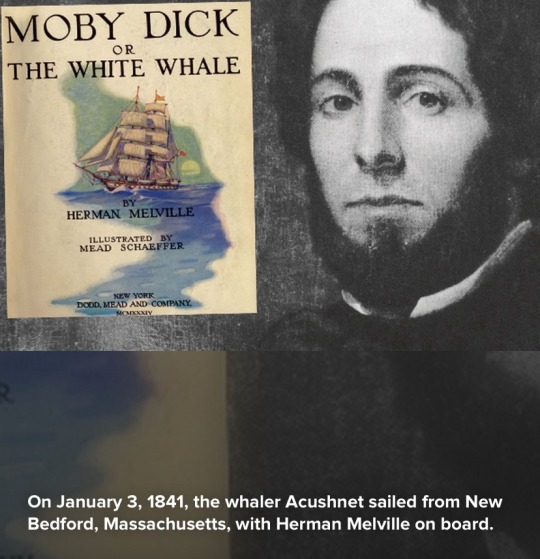#acushnet
Text

Cookie Dough | Acushnet Creamery
240 notes
·
View notes
Text

Pulmosan Full Face Masks, part 1
Pulmosan (from the Latin word Pulmo, for lung, and Sanitas, for Health, literally "Lung Health, or Sanitary Breathing" ig) is one of the more interesting US industrial gas mask sellers of the 20th century. Although they did not design many masks in house, they did manufacture a wide variety of designs that ran the gamut from cutting edge to downright bizarre. In the short time that I'm home currently I'm trying to get some basic documentation down, admittedly the photos kind of suck but it's something to work off of.
Shown here, from left to right:
Mine Safety Appliances manufactured Burrell Kops-Type, itself a copy of the US Army Chemical Warfare Service's Kops-Tissot-Munro mask, rebranded for sale by Pulmosan. 1920's-30's.
Pulmosan designed and manufactured 1600-J "Fumegard", 1910's-20's
Acushnet designed, Pulmosan manufactured 1600-J, 1930's-40's
Acushnet designed, Pulmosan manufactured 1600-J, 1930's-40's
Acushnet designed, Pulmosan manufactured 1600-J, 1940's-50's
Pulmosan designed, manufactured and patented "Fear-Not", 1930's. These are probably Pulmosan's strangest and hopefully will get their own post later.
3 notes
·
View notes
Photo
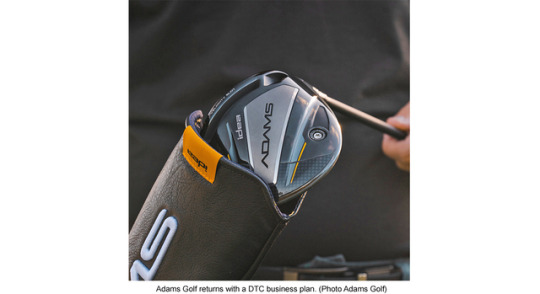
Adams Golf’s Idea–Direct to Customer
By ED TRAVIS
The selling of golf clubs and balls is a predictable process, at least for the major manufacturers. Though each spends millions for endorsement by professional tour stars marketing plans usually place emphasis on where the company feels they have an advantage—for example, Callaway Golf’s Paradym drivers or Acushnet Company’s Titleist golf balls.
A key for the big manufacturers to pushing club and ball sales is establishing relationships with the so-called green grass shops found at every golf course and run by a PGA Professionals plus off-course vendors especially big box multiple location retailers while promoting online sales through their own websites and sites run by independents.
Adams Golf, which had all but disappeared after TaylorMade’s purchase in 2012 for $70 million, is taking a different route to re-establish itself with golfers. They have introduced a club family under the Idea brand name which is being sold DTC only from its website…no green-grass, no big box, no brick and mortar.
Of course, smaller, niche-focused makers sell online but often offer only a limited selection, perhaps just putters or balls. None of the major brands have opted to enter the market with a separate brand and then sell only DTC. For example, Callaway has the Big Bertha family and Tour Edge Golf the Hot Launch line, but neither is sold solely over the Internet.
To add to the attractiveness Adams/TaylorMade has decided to price the Idea clubs at the lower end of the current price spectrum with shaft selection limited to a single stock model though options of steel or graphite are offered in the irons. An Adams Idea driver, a fairway wood, two hybrids and seven irons may be purchased for just about $1500 while the latest from parent TaylorMade, a Stealth 2 driver, one fairway wood and two hybrids lists cost approximately the same amount and that doesn’t include the Stealth irons which could be another $1000. Adams ships at no cost for orders over $99.
An interesting business plan, TaylorMade creating in-house competition. Not unheard of in retail but always to be approached with a complete understanding of how the main, money-making brand will be affected when faced with a lower priced rival offering presumably the same quality though it could be argued performance may be significantly different. The company certainly believes that for a generation of consumers familiar with online purchasing, golf clubs on the web without a potentially intimidating store visit is worth the investment.
Adams Golf was started by Barney Adams in 1991 and his Tight Lies hybrid design changed hybrids forever with its innovative Tri-Sole that helped average players get the ball out of most any lie, long grass or even sand.
The Idea line can boast some of the latest design features and though they may not be as sophisticated as the TaylorMade Stealth still are attractive for use by new golfers and those returning to the game. For example, the draw-bias Idea driver has a carbon fiber crown, an adjustable hosel and sole slot while the cavity back irons are a hollow body construction with a variable thickness face.
In other words, many of the same talking points as any of the major makers competing clubs. The question is can TaylorMade revive Adams Golf with this one-of approach or will Adams slip back into obscurity.
3 notes
·
View notes
Text
#unhallowedarts - Raising Monsters: Melville's Moby Dick

“Ye Gods! What a commentator is this Ann Alexander whale. What he has to say is short & pithy & very much to the point. I wonder if my evil art has raised this monster."
Thusly cried Herman Melville in London, back in 1851, just a few weeks before the publication of the cetacean novel that hardly anyone felt compelled to read for the next 70 years. A huge sperm whale had attacked and sunk the good ship “Ann Alexander” out of New Bedford some 2,000 miles east of the coast of Peru. It was one of the rare but not unheard of incidents when a bull sperm whale had attacked a ship three times his own size. And while the monster was slain in January 1852 by the crew of another New Bedford whaler, the “Rebecca Sims”, off the Galapagos Islands, another whale of a tale was still told along the Eastern Seaboard: the story of the “Essex”, sunk by a sperm whale out in the open Pacific Ocean in 1820 along with the spine-crawling ordeal of her crew’s survival.
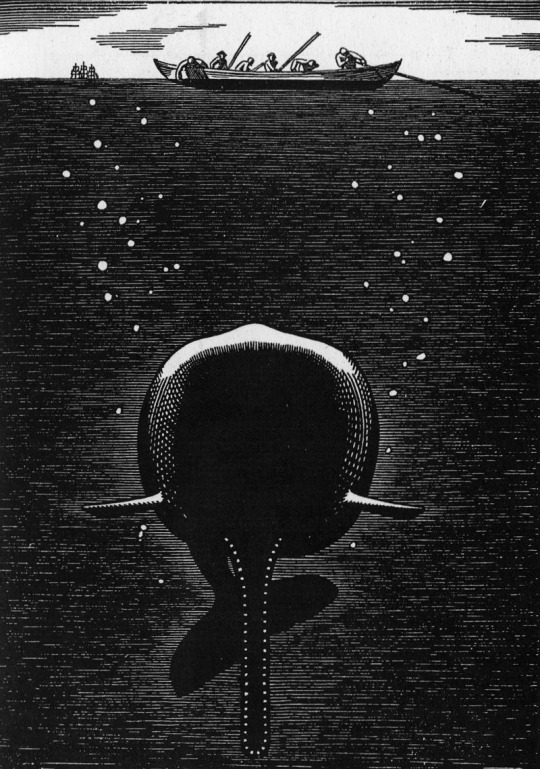
The story became one of the major inspirations for Melville, along with the account of “Mocha Dick”, a white bull sperm whale with his head covered in barnacles, his peculiar method of spouting and his ability to come out of the water completely when he breached in anger, recorded in the “Knickerbocker” magazine in 1839. And there was Melville’s own experience, gathered aboard the whaler “Acushnet” of Fairhaven, Mass., and the Australian whaleship “Lucy Ann”, a time 23 years old Melville found so unbearable that he felt compelled to jump ship twice. But even though “Moby Dick” comes in the guise of a fable about the harsh days of whaling, the gory business is but a background, almost a sideshow of America’s greatest novel.

Melville’s audience expected something along the lines of “Typee” or “Omoo”, both best-selling novels inspired by the author’s adventures in the South Pacific. However, “Moby Dick” came as 200,000 word leviathan full of allusions and elaborations on Homer, Shakespeare, Milton, Byron, the Scriptures, marine mammals, quotes from completely obscure sources and, of course, the sea. Unfortunately, the majority of the American readers’ tastes had turned westward to the Great Plains and California after gold had been found at Sutter’s Mill in 1848, causing a period of migration in the Northern Hemisphere.

Yarn of Nantucket sleigh rides, whales and sailors were no longer that interesting, but the attempt to capture the totality of human existence and cram it aboard a whaler, anticipating the great Russian novels of the late 19th century and the classical modernists, Joyce, Dos Passos and Döblin, was simply too much to stomach. It took the turmoil of the 20th century to ripe readers for “Moby Dick” and its baroque tour-de-force through the summary of literary experience of almost 3,000 years. In 1902, almost like a symbol for the change of the audience and the appreciation of the novel, a white sperm whale was killed off the Azores, a 90’ long scarred old bull, veteran of uncounted fights, allegedly a hundred years old. The modern whalemen brought him down with a modern harpoon tipped with an explosive device.

All illustrations above by Rockwell Kent (1882 -1971) for the 1930 edition of Herman Melville's "Moby Dick"
#unhallowedarts#dark aesthetic#dark literature#classic literature#classic fiction#moby dick#herman melville
5 notes
·
View notes
Text
Unveiling the Champions: A Deep Dive into Golf Club Market Share (2024)
The golf club market swings with power and precision, shaped by iconic brands and a constant pursuit of innovation. But who are the major players dominating the fairways? Let's delve into the fascinating world of golf club market share by brand and region, using 2024 estimates to paint a clear picture.

The Titans Tee Off: Global Market Share Leaders
The "Big Three" continue to hold a dominant position in the global market:
Callaway Golf: Estimated to hold around 25% of the global market share, Callaway remains a leader in innovation and caters to a wide range of golfers.
TaylorMade Golf: Hot on Callaway's heels with roughly 22% of the market, TaylorMade is known for pushing club design boundaries and offering tour-level performance.
Titleist (Acushnet Holdings Corp.): This premium brand occupies an estimated 18% of the market share. Titleist focuses on high-performance equipment and boasts a loyal following among serious golfers.
These established giants have built their empires on:
Decades of Experience: Their long-standing reputation for quality and innovation creates a sense of trust and brand loyalty amongst golfers.
Extensive Product Lines: From drivers to wedges and putters, they offer a broad spectrum of options for all skill levels and budgets.
Tour Player Endorsements: Sponsoring professional golfers showcases their equipment's capabilities and influences consumer choices.
Regional Variations: A Look Beyond the Majors
While the "Big Three" dominate globally, regional preferences play a significant role:
North America: The traditional powerhouses (Callaway, TaylorMade, Titleist) reign supreme, but niche brands like Cobra Golf and PING enjoy strong followings.
Europe: European brands like Srixon (Japan, owned by Sumitomo Rubber Industries) and Mizuno (Japan) have a larger market share compared to other regions.
Asia Pacific: The market is witnessing significant growth, with Japanese brands like Srixon and Yonex gaining traction alongside established global names.
These regional variations can be attributed to factors like:
Brand Legacy: Local brands with strong historical roots may have a loyal following within their respective regions.
Cultural Preferences: Playing styles and preferences can differ across regions, influencing brand choices.
Distribution Networks: Strong regional distribution networks can give certain brands a competitive edge in specific markets.
Emerging Contenders and Market Shifts
The golf club market isn't static. Here are some key trends shaping the future landscape:
Direct-to-Consumer Growth: Online retailers and brand-owned websites are offering convenience and competitive prices, challenging traditional brick-and-mortar stores.
Focus on Fitting: Custom fitting is becoming increasingly important as golfers seek clubs perfectly matched to their swing mechanics.
Technological Advancements: New materials, innovative designs, and data-driven club development are pushing the boundaries of performance.
Niche Market Focus: Brands catering to specific demographics, like women's clubs or game-improvement options, are attracting loyal customers.
Finding Your Perfect Match: Beyond Market Share
While golf club market share provides valuable insights, the best brand for you depends on your individual needs. Here are some tips for choosing the right clubs:
Consider Your Skill Level: Beginner, intermediate, or advanced golfers will have different equipment requirements.
Get Fitted: A proper fitting by a qualified professional can significantly improve your game and club performance.
Research and Compare: Explore different brands and models within your budget to find the ideal fit for your swing and preferences.
The golf club market offers a diverse and ever-evolving landscape. So, take aim at the green, armed with knowledge and a swing that matches your chosen brand. Remember, the perfect clubs are the ones that help you unlock your golfing potential!
0 notes
Text
0 notes
Text
Golf Bags Market Global Expansion Strategies by Top Vendors till 2030
The Insight Partners is excited to announce the release of groundbreaking findings in its latest market research report, "Overview of Golf Bags Market Share, Size, and Forecast | 2030". The panoramic research, conducted by our team of seasoned experts, provides valuable insights on the Golf Bags market forecast, key trends, drivers, challenges, and opportunities within the Golf Bags market.
The report unveils a detailed Golf Bags market analysis of the current Golf Bags market size and projects future growth trends based on historical data and market dynamics. At our research firm, we aim to help investors by providing both qualitative and quantitative data through this study. This global Golf Bags market report, competitive landscape, risks and barriers to entry for market players, sales channels, distributors, and Porter's Five Forces Analysis.
Businesses must have a firm understanding of the market, before making significant investments. It makes financial sense to allocate a modest portion of your company's expenditure to reliable market research. With a team of well-versed experts, we deliver actionable insights and strategic intelligence to help businesses navigate the complexities of the market landscape. Our commitment to excellence and innovation sets us apart as a trusted partner for organizations seeking a competitive edge.
Why Opt for Our Golf Bags Market Research Report?
Our researchers employ a multi-faceted approach to data collection, utilizing primary and secondary sources to ensure the breadth and depth of information.
Our researchers analyze consumer behavior, market trends, and brand positioning methods. Every piece of data undergoes a rigorous validation process to ensure accuracy and reliability.
We prioritize clarity and conciseness in our reporting, presenting findings in a format that is easily digestible for our clients.
We develop customized analytical models tailored to the specific nuances of the Golf Bags market, allowing us to uncover hidden patterns and trends.
The report answers the following questions:
What are the primary factors driving the Golf Bags market growth during the projected period?
What region is likely to witness the most substantial growth?
Which Golf Bags market trend will take center stage in the coming years?
What are the key challenges hindering the Golf Bags market expansion?
Emerging Trends: Our report uncovers emerging trends that are poised to reshape the Golf Bags market equipping businesses with the foresight to stay ahead of the competition.
Competitive Landscape: The Insight Partners explores the competitive landscape, offering insights into key Golf Bags market players, their strategies, and potential areas for differentiation. The key companies in the Golf Bags market are Callaway Golf Company, TaylorMade Golf Co., Roger Cleveland Golf Company, Inc, Acushnet Holdings Corp., FINGER TEN, Under Armour Inc., Mizuno USA., Real Leather Studio, BELDING, Forgan .
Consumer Insights: Understanding consumer behavior is pivotal. The report includes a comprehensive analysis of consumer trends, preferences, and purchasing patterns.
Market Segmentation- The report breaks down the Golf Bags market into key segments, providing a detailed examination of each segment's market size, Golf Bags market growth potential, and strategic considerations.On the Basis of Type this market is categorized further into-
Type (Tour Bags
Cart Bags
Stand Bags
Others)
On the Basis of Distribution Channel this market is categorized further into-
Distribution Channel (Supermarkets and Hypermarkets
Specialty Stores
Online Retail
Others)
Key regions Golf Bags Market Research Report:
North America (U.S., Canada, Mexico)
Europe (U.K., France, Germany, Spain, Italy, Central & Eastern Europe, CIS)
Asia Pacific (China, Japan, South Korea, ASEAN, India, Rest of Asia Pacific)
Latin America (Brazil, Rest of Latin America)
The Middle East and Africa (Turkey, GCC, Rest of the Middle East and Africa)
Rest of the World
Published By
Diya Jadhav
0 notes
Text
Golf equipment Market : Prospects for Growth in Developing Economies
“According to the research report, the global golf equipment market was valued at USD 7.45 billion in 2021 and is expected to reach USD 11.33 billion by 2030, to grow at a CAGR of 4.8% during the forecast period.”
Polaris Market Research has unveiled an updated report on Golf Equipment Market Share, Size, Trends, Industry Analysis Report, By Product (Golf Club, Golf Balls, Golf Gear, Golf Bags, Golf Footwear, and Apparel); By Distribution Channel; By Region; Segment Forecast, 2022 - 2030, that provides a thorough analysis of the market status with the best facts and figures, definitions, applications, and the latest developments across the globe. The report assesses the industry structure based on Golf Equipment Market size, segments, source, distribution channel, and major regions. It scrutinizes the latest trends in the industry and studies their impact on the overall market environment. The market has evolved swiftly in recent years and has made a remarkable contribution to global finances in terms of growth rate, Golf Equipment Market share, and revenue generation.
Get Sample PDF with Report Insight @ https://www.polarismarketresearch.com/industry-analysis/golf-equipment-market/request-for-sample
Key Market Dynamics
This analytical study report provides information on significant aspects of the market, such as dynamics, key demand and price, technology trends, and detailed profiles of key players, industry revenue, and regional segments analyzing the Golf Equipment Market based on SWOT and Porter's Five Forces models. Details of segment markets by type, application, and region have been covered in this report, with historical data presented in metrics of sales volume, revenue, and growth rate.
Key Offerings:
Industry Dynamics
Golf Equipment Market Segmentation
Market Size in terms of Value and Volume: Current, Historical, and Projected Data
Industrial Trends and Developments
Competitive Landscape
Opportunities in the market
Strategies and Products offerings of Major Players
Strategic Recommendations for the new entrants
Production and Consumption Analysis by Regions
Growth Prospects with Revenue Estimations
Main Findings and Insights
The next section gives a detailed description of the key drivers, restraints, growth opportunities, challenges, and risks in the market. Further, the development status and future Golf Equipment Market trends are tracked in the report. The supply chain and cost analysis in the report are both explained in-depth. Through technological innovation and advancement, the product's performance will be further optimized, expanding its use in downstream applications. Additionally, readers will find market dynamics and consumer behavior studies as essential data for understanding the market.
Top Key Players:
Anta Sports Products Limited (Amer Sports)
Acushnet Holdings Company Limited
Adidas Group
Bridgestone Group
Callaway Golf Company
Cleveland Golf Corp.
Dunlop Sports Co. Ltd.
Dixon Golf Inc
Golfsmith International Holdings Inc.
Mizuno Corporation
Puma SE
PING Inc.
Roger Cleveland Golf Company Inc
SRI Sports Limited
Sumitomo Rubber Industries
Nike Inc.
Taylormade Golf Company Inc.
Wilson Sporting Goods.
Golf Equipment Market key players are presented along with their expansion plans, share, strategies, and business overview. In addition to this, their company profiles, sales figures, profit margins, and product and service portfolios are evaluated in the report. The chapter sheds light on the business expansion strategies employed by these players, such as mergers and acquisitions, product launches, collaborations, M&A, contracts, partnerships, and joint ventures.
Inquire your Questions If any Before Purchasing this Report @ https://www.polarismarketresearch.com/industry-analysis/golf-equipment-market/inquire-before-buying
How Will This Report Help you?
The report delivers extensive analysis in the form of figures, tables, charts, and graphs combined with an in-depth study of current and future Golf Equipment Market prospects. It further allows readers to comprehend the competitive regional pattern by comparing the sales volume and revenue of the world's key regions. Import volume and export volume are evaluated on a regional level. Key statistical insights are presented in a straightforward manner that will users grasp the market's development patterns, crucial factors, and other loopholes which are expected to affect the market expansion.
Key Regions Covered By Report:
North America (United States, Canada, and Mexico)
Europe (Germany, France, United Kingdom, Russia, Italy, and the Rest of Europe)
Asia-Pacific (China, Japan, Korea, India, Southeast Asia, and Australia)
South America (Brazil, Argentina, Colombia, and the rest of South America)
The Middle East and Africa (Saudi Arabia, United Arab Emirates, Egypt, South Africa, and the Rest of the Middle East and Africa)
The entire market industrial chain is examined in the research, from the important upstream raw materials and their suppliers to the midstream distributors and downstream customers, while taking the effects of global inflation into account. Finally, it predicts the market's future trends from the perspectives of various types, uses, and significant geographical areas. This study is a trustworthy source for market research that will greatly accelerate the growth of your business and increase its presence in the Golf Equipment Market.
Browse Additional Details on "Golf Equipment Market" @ https://www.polarismarketresearch.com/industry-analysis/golf-equipment-market
Reasons to Purchase This Report
This research includes a thorough worldwide and regional analysis of the market.
It gives thorough coverage of every sector of the market in order to assess prospective trends, growth plans, and industry size projections.
The firm profiles of each industry player examine the industry portfolio, sales income, SWOT analysis, and current advancements.
Comprehension of the market's drivers, restrictions, and key small markets.
Analysis of collaboration and authorizing transaction trends can be used to identify commercial prospects in the market sales scenario.
The research analyzes how specific industry structures, ideas, or technological advancements may help with player promotion.
About Us
Polaris Market Research is a worldwide market research and consulting organization. We give unmatched nature of offering to our customers present all around the globe across industry verticals. Polaris Market Research has expertise in giving deep-dive market insight along with market intelligence to our customers spread crosswise over various undertakings. We at Polaris are obliged to serve our different client base present over the enterprises of medicinal services, healthcare, innovation, next-gen technologies, semiconductors, chemicals, automotive, and aerospace & defense, among different ventures, present globally.
Contact Us:
Polaris Market Research
Email: [email protected]
Ph: +1-929 297-9727
0 notes
Text
Titleist/Acushnet Pushes Back Against USGA Ball Rollback
A recently released public statement from Acushnet makes me think that the USGA either has not done all of their homework or is being disingenuous.
Titleist/Acushnet Pushes Back Against USGA Ball Rollback
A recently released public statement from Acushnet makes me think that the USGA either has not done all of their homework or is being disingenuous.
Acushnet (Titleist) CEO David Maher suggests right up front that golf, in fact, does NOT have a distance problem.
At a time when interest in golf is vibrant (2023 will mark the 6th…
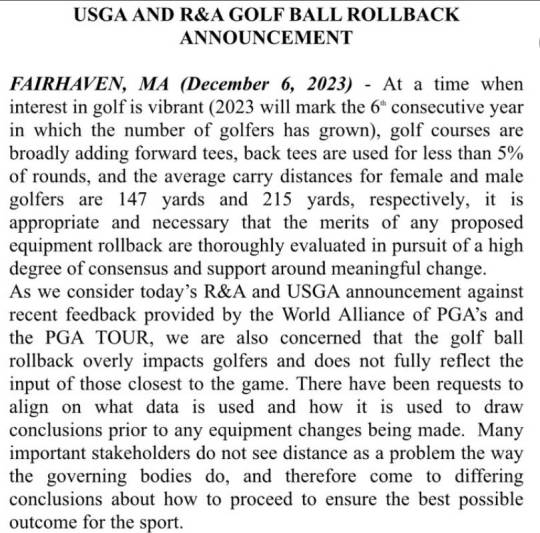
View On WordPress
0 notes
Text

Espresso Brownie Fudge | Acushnet Creamery
209 notes
·
View notes
Photo

Full Speed into the Past
By ED TRAVIS
After taking a few days to think about the implications of a proposed rules change announced Tuesday March 14 by golf’s governing bodies, the USGA and R & A, the conclusion is clear. By decreasing the distance standard for golf balls played by so-called elite golfers, in effect rolling back the ball to the performance characteristics of twenty years ago, it is a solution in search of a problem.
It’s almost certain in three years when the rule would go into effect fans of elite golf—college and professional—can look forward to seeing the big guys not hit it so big which is a negative for sure but the bigger problem more likely will be the reaction of ball makers such as Acushnet and Callaway.
In situations like this in the past—remember the long putter or square grooves–it says more about the governing bodies desire to control our game decades in the future rather than helping those with emotional and financial stakes in the game capitalize on the current growth trend. Why can’t we just make golf more attractive to play and watch rather than adding more restrictions?
It seems whenever the USGA is involved, their focus on the tradition and integrity of the game (whatever that’s supposed to mean), fans come out in second or third place. Referring to further restricting ball performance golf instructor Hank Haney said it several years ago, “People don’t go to a ball game to watch them hit bunt singles.” Fans don’t go to PGA Tour events to marvel at clever chip shots, holed three-footers or perfect 150-yard nine-irons. They go to watch the big guys smash the ball distances we can only dream about.
Otherwise, you might as well go bowling.
The governing bodies continue to be focused on what happened in the past not where the game is today and if there is one thing sure in this world it is you can never go back.
Certainly, at the elite professional level golf is entertainment and changing equipment to make golf less entertaining means fans are the losers.
In case you think the proposed rules change has a chance of not being adopted remember former USGA CEO Mike Davis swore the last think he would do is roll back the ball. The pandemic may have slowed down the process, but current CEO Michael Whan will ensure it happens.
They say the new distance standard in effect January 1, 2026, will only apply to the few thousand elite players in the world or using the word nobody says out loud, bifurcation. However, there is no assurance that won’t change and indeed since the U.S. Open and the British Open will enact the restricted ball specifications should “regular players” qualify they would have to comply certainly in the qualifying rounds too.
As far as the other major championships are concerned, the Masters probably will want to make use of a reduced distance ball—estimated at 14-15 yards less—but the PGA of America who runs the PGA Championship has not said what they will do.
If anyone knows that professional golf must be entertaining it is the PGA Tour and maybe they will not agree to use a reduced distance ball. They do know they must sell themselves to fans and comments by many current Tour members are against implementation. Further should the Tour opt out, that would create the interesting situation of week to week play with the “long ball” and two weeks annually, the U.S. and British Opens, having to play the “short ball.”
That makes no sense whatsoever. The PGA Tour is also in a competitive situation with LIV Golf and there is zero chance LIV will play the short ball. Additionally, the USGA says elite female players will not have to play the short ball, so the LPGA Tour doesn’t have a decision to make.
But what about the golf ball manufacturers you ask? An excellent question and according to a statement from Acushnet Company, the largest ball manufacturer, “Under the proposed guidelines, events that adopt this MLR [Model Local Rule] would require players to use a substantially shorter golf ball, similar in distance to what was available in the 1990’s.”
Do you remember the Titleist Professional? A fine ball, at the time everyone played it, but it was instantly out of date with the introduction of the solid core urethane cover Titleist Pro V1 in 2000. Ball makers marketing now is built around the average player being able to tee up the same ball as the PGA Tour stars. This aspirational quality of golf is integral to the charm, resiliency and long life of the game.
Singling out the golf ball is not a sound analysis of the situation when swing speed on the Tour continues to increase (2.23 mph in the past 15 years) but it would seem logical there is at some time an upper limit on the increasing athleticism of Tour players. That would limit the swing speed increases and therefore distance off the tee and with other clubs.
We haven’t heard the last from the ball makers and lawsuits are a possibility creating another mess caused by the USGA’s myopic view of modern golf.
3 notes
·
View notes
Text
Tee Up for Success: Analyzing the Major Players in the Golf Products Market
From driver distance to putting prowess, the golf products market caters to enthusiasts of all skill levels, swinging its way towards a projected US$10.2 billion by 2028. But who are the bigwigs wielding the most influence on the green? Let’s take a closer look at the major players and their competitive landscape:
Titans of the Tee:
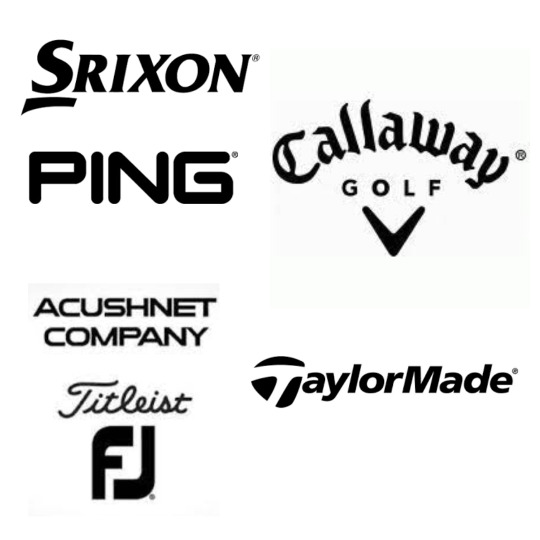
Callaway Golf Company: A dominant force with a diverse product range, appealing to both professionals and amateurs.
Strengths: Strong brand recognition, innovative technologies, global reach.
Weaknesses: Price sensitivity of some consumers, potential saturation in certain product segments.
TaylorMade Golf Company: Renowned for its performance-driven clubs and bold designs.
Strengths: Strong tour player endorsements, focus on data and analytics, high-tech equipment.
Weaknesses: Premium pricing, niche focus might alienate some golfers.
Acushnet Holding Corp. (Titleist): Beloved by professional golfers, known for premium quality and heritage.
Strengths: Strong brand loyalty, tour success, high-performance products.
Weaknesses: Limited appeal to casual golfers, potentially higher price points.
PING Golf Company: Focuses on custom fitting and innovation, catering to a specific golfer profile.
Strengths: Expertise in custom fitting, emphasis on playability, loyal customer base.
Weaknesses: Limited brand awareness compared to larger competitors, smaller product range.
SRIXON (Sumitomo Rubber Industries, Ltd.): Strong presence in Asia, known for value-driven products and performance.
Strengths: Competitive pricing, good quality, growing global reach.
Weaknesses: Limited brand recognition in some markets, smaller market share compared to major players.
Rising Stars in the Bunker:

PXG: A disruptive brand offering high-performance, fully-adjustable clubs.
Strengths: Unique technology, focus on customization, celebrity endorsements.
Weaknesses: Limited brand history, premium pricing, smaller product range.
Cobra Golf: Making a comeback with innovative technology and player-focused designs.
Strengths: Strong tour presence, focus on forgiveness and distance, value-driven offerings.
Weaknesses: Smaller market share compared to major players, need to build brand awareness.
Mizuno: Popular among skilled golfers, known for craftsmanship and performance.
Strengths: Strong brand reputation, loyal following, high-quality products.
Weaknesses: Limited reach to casual golfers, potentially higher price points.
Cleveland Golf: Offers value-driven products for beginner and mid-handicap golfers.
Strengths: Affordability, good performance, focus on game improvement.
Weaknesses: Limited appeal to high-end golfers, smaller brand recognition compared to major players.
Competition Heats Up:

Callaway: Leverages brand heritage, invests heavily in R&D, and offers a wide range of products for all levels.
TaylorMade: Prioritizes data-driven design, tour player endorsements, and high-tech equipment.
Titleist: Emphasizes premium quality, heritage, and tour success to appeal to serious golfers.
PING: Focuses on custom fitting, playability, and a loyal customer base.
SRIXON: Offers a mix of value, performance, and growing brand awareness.
PXG: Disrupts the market with innovative technology and a premium, customized experience.
Cobra: Uses player-focused designs, tour presence, and value-driven offerings to regain market share.
Mizuno: Relies on craftsmanship, performance, and brand reputation to attract skilled golfers.
Cleveland: Focuses on affordability, game improvement features, and catering to beginner and mid-handicap golfers.
Future Forecast: Birdies on the Horizon
The golf market is expected to see continued growth, driven by factors like:
Rising interest in golf, especially among younger demographics.
Technological advancements leading to more innovative equipment.
Focus on personalization and customization for individual golfers.
Expansion into emerging markets with growing disposable income.
The Final Round: More Than Just Birdies
The golf products market is a dynamic arena with diverse players vying for your swing. By understanding their strengths, weaknesses, and strategies, you can make informed decisions about your next equipment purchase or gain valuable insights into the industry.
0 notes
Link
Check out this listing I just added to my Poshmark closet: Titleist Model 90 Iron Regular Flex Steel Acushnet Original Grip Golf Club.
0 notes
